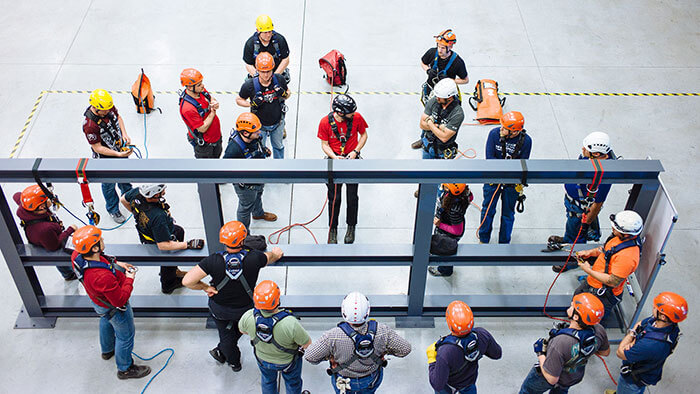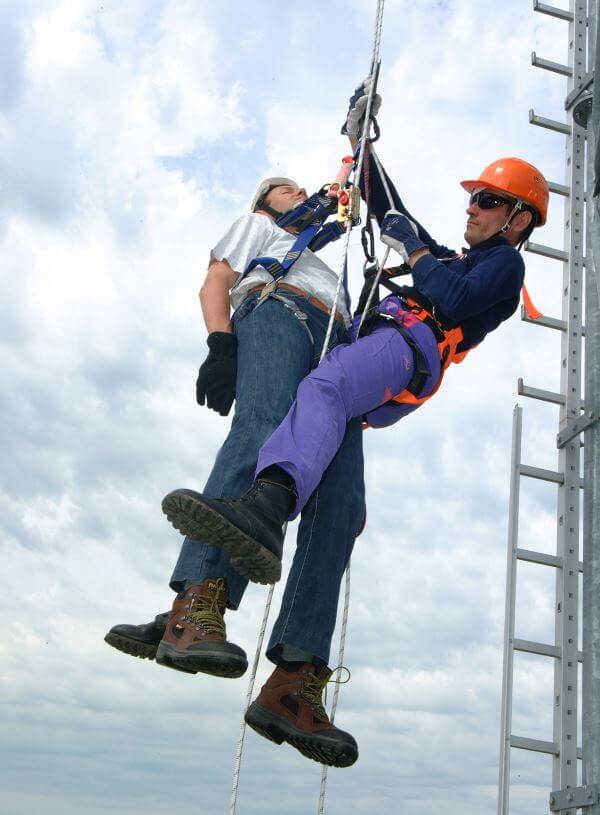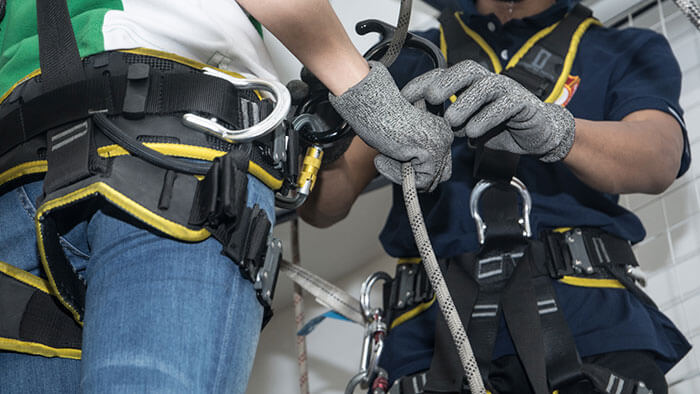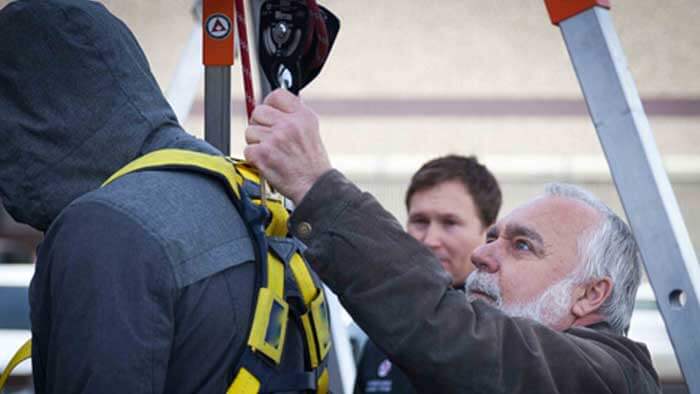Since April 1st, 2015, anyone on a project exposed to a fall hazard needs to be trained according to the CPO training standard for “Working at Heights” (WAH) by an approved provider (insert shameless self-promotion here – Yup! Industrial Safety Trainers is an approved provider, the best in my humble opinion).
The training is valid for three years, at which point a refresher course must be taken. Now, none of this information is new, and I’m sure most of you reading this are wondering, why even bring it up? As a trainer, I have been doing a fair amount of WAH refresher courses, and I am noticing some trends that are good points of discussion.
What stands out the most for me is what I’m calling “tie-off fatigue”.

What I mean by this is simple – as more time passes and more workers are retrained about the same topics over and over, they seem to be tired of hearing the same message. I am told that what is said in training doesn’t realistically reflect the culture in construction.
So, at this point, I can already hear people challenging that broad generalization – and yes, you are correct – it is a broad generalization. If your organization is the beacon of safety that we should all aspire to, fantastic! I love hearing positive things.
Profit over safety is an all too common occurrence as far as I am concerned (full disclosure – I also do not own a business and therefore am not under the same constraints).
But whatever the case, I have some questions for employers and supervisors:
- Have you considered a worst-case scenario, such as a medical event at heights?
- As it relates to the availability of equipment for fall rescue, do you have lowering devices that are suitable for conscious and unconscious workers?
- If an event were to occur, how long would it take to perform a rescue?
- Have you practiced a fall (in a safe manner, obviously – with a Rescue Randy safety dummy)
- Have you trained all workers in the specifics of YOUR onsite rescue plan?
- What about training for suspension trauma?
- Is your site-specific rescue plan updated as construction stages change?
I have asked these questions routinely to participants taking WAH refresher training, and I have yet to get many positive answers. I am occasionally even met with a “you’re lucky I even wear the silly harness!” – This is from a worker’s perspective. What I would like to talk about here are the employer’s obligations under the OHSA and O. Reg 213.
Job Site Safety Plan
The Occupational Health and Safety Act states that “an employer shall provide information, instruction and supervision to a worker to protect the health or safety of the worker” (S. 25(2)(a)). This means that workers are entitled to information about the hazards they will be encountering in their workday.
It means they are to be instructed on how to handle these encounters and supervised so they will make the correct choice. A framework needs to be created and provided so that these obligations can be complied with the development of a fall protection plan.
A fall protection plan is a document that is based on your fall hazard risk assessment. OHSA S. 25 (2)(d) states “acquaint a worker or a person in authority over a worker with any hazard in the work…” which means that the employer must be aware of, and make others aware of, all fall hazards – prior to allowing work to commence.
What your fall protection plan should include would be the identification of hazards for certain work activities and what controls the employer has put in place to mitigate by using the hierarchy of controls.
To be honest, outside of larger constructors, I am not aware of many of these plans actually being created and shared with their workers on site.
We discuss its importance in the WAH certification course, but upon refresher… it may have slipped through the cracks! If, in fact, you have
one, just like the WAH certification, you need to be retraining workers about your policies and procedures to ensure they continue to protect
workers.
Just to make your life easier, you can always use our “Job Site Safety Plan” template as a basis for your own.
Fall Protection and Rescue Plan

So now that I reminded you about completing that’s risk assessment and fall protection plan you *may* have been putting off (you’re welcome by the way) let’s now get a little bit more specific about one element that is mandatory, yet also frequently neglected – the rescue plan.
The general requirements section of the construction regulations state “A constructor shall establish for a project written procedures to be
followed in the event of an emergency and shall ensure that the procedures are followed at the project” (S. 17(1)), which covers the constructor’s duty to ensure overall site safety, but what about all of the smaller employers and their workers performing work on the project? That DOES get VERY specific.
Firstly, according to O. Reg 213 S. 26.2 (1):
“An employer shall ensure that a worker who may use a fall protection system is adequately trained in its use and given adequate oral and written instructions by a competent person.”
So are you compliant? Have you created the above-mentioned documentation as it pertains to fall hazards your workers are likely to be exposed to? Examples include what pieces of equipment are permitted by the employer (ladders, EWPs, scaffolds), where work is to be done at what stage of the build, or designated tie-off points for certain tasks.
If you have completed your plan, then we are good! Let’s move on to that rescue component!
When I am teaching a WAH refresher course, I always like to ask the participants what they have used (in terms of knowledge) from their last WAH course. Needless to say, I get a variety of answers that span all possibilities.
One thing that isn’t really mentioned is the presence of a strong and practiced rescue procedure.
This could be for a multitude of reasons, including anything from constantly changing environments to a lack of internal ability. Whatever camp you find yourselves in, the rules around this issue are fairly clear. O. Reg 213 S. 26.1(4) states, “Before any use of a fall arrest system or a safety net by a worker at a project, the worker’s employer shall develop written procedures for rescuing the worker after his or her fall has been arrested.” Which means it isn’t optional.
For a successful rescue to take place, a few elements need to be covered. Employers need to focus on leadership as it pertains to Working at Heights. If management is not committed or aware of their obligations, then how can workers be expected to be?
At an HRPA conference last year, I heard someone say, “A good leader doesn’t light a fire under you but inside you.”
I’ll be the first to admit that it is a slightly corny line, but it rings true.
Employers and supervisors need to get buy-in from their staff to be successful in many elements of your business – but it is critical. Management has to show their dedication to this legally mandated issue; it cannot be viewed as a necessary evil.
Management needs to be that element of enforcement. Rules that are not enforced are rules that do not really exist.
Looking good on paper and being good in practice are two totally different things.
Employers must also focus on what rescue plans are appropriate for your worksite, what equipment will be used for rescue, and how. If you would like a template to help steer you in the right direction, we have one for you.
Click here to download a sample rescue plan
Final Steps
The final step here is ensuring that your plan is PRACTICED! As employers, you want those designated to perform the rescue to be able to step in when a problem arises. You want that rescue to be fast, safe, and efficient. For this to occur – you need those involved to have muscle memory. You want their training to take over in these stressful situations.
You want everyone to go home safely at the end of the day.
Your next step? Get the motivation to complete your fall hazard risk assessment. Build that fall protection plan around YOUR hazards. Plan for the worst-case scenario, get the crucial equipment and practice those rescues. I’ve lowered enough Rescue Randy dummies off of wood poles in my past to know it makes a HUGE difference.
I hope you enjoyed your WAH refresher training for employers! The passing grade comes with what you do next. See you again in 3 years.
Geoff Rowatt
Health & Safety Trainer | CHRP


